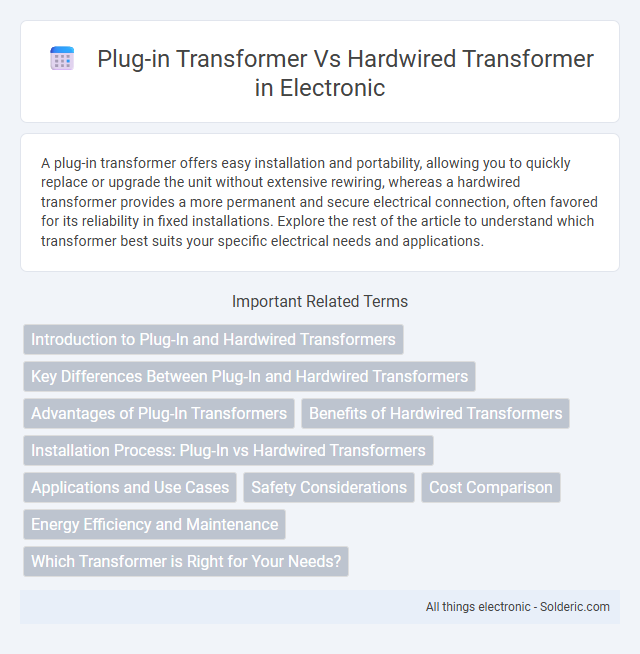A plug-in transformer offers easy installation and portability, allowing you to quickly replace or upgrade the unit without extensive rewiring, whereas a hardwired transformer provides a more permanent and secure electrical connection, often favored for its reliability in fixed installations. Explore the rest of the article to understand which transformer best suits your specific electrical needs and applications.
Comparison Table
| Feature | Plug-in Transformer | Hardwired Transformer |
|---|---|---|
| Installation | Easy plug-in connection, quick swap. | Permanent wiring, fixed installation. |
| Maintenance | Simple replacement, minimal downtime. | Complex repair, requires skilled technician. |
| Flexibility | High, supports modular upgrades. | Low, limited adaptability. |
| Cost | Generally higher initial cost. | Lower initial cost, higher labor cost. |
| Reliability | Reliable with secure plug connections. | Highly reliable with solid hardwired connections. |
| Application | Suitable for modular and portable systems. | Ideal for permanent, stationary installations. |
Introduction to Plug-In and Hardwired Transformers
Plug-in transformers offer convenient installation with plug-and-play functionality, ideal for applications requiring easy replacement and flexibility. Hardwired transformers provide a permanent and secure electrical connection, ensuring reliability and stability in fixed installations. Understanding the distinct features of plug-in versus hardwired transformers helps you choose the right solution for your electrical system needs.
Key Differences Between Plug-In and Hardwired Transformers
Plug-in transformers offer easy installation and portability by simply plugging into standard outlets, making them ideal for temporary or flexible applications, whereas hardwired transformers require direct electrical connections and are suited for permanent, fixed installations. Plug-in models often have built-in safety features and standardized connectors for quick replacement, while hardwired transformers provide higher customization options for specific voltage and current requirements. The choice between them depends on the project's flexibility needs, installation complexity, and electrical load specifications.
Advantages of Plug-In Transformers
Plug-in transformers offer increased flexibility by allowing easy replacement or maintenance without the need to disconnect wiring, reducing downtime and labor costs. Their modular design supports quick upgrades or customization tailored to your specific voltage and power requirements. These transformers also improve safety by minimizing exposure to live connections during installation or service.
Benefits of Hardwired Transformers
Hardwired transformers provide superior durability and safety due to their fixed, permanent connections, reducing the risk of loose contacts or electrical faults. They typically offer improved electrical performance with lower resistance and minimal energy loss compared to plug-in transformers. Your electrical system benefits from enhanced reliability and stability, making hardwired transformers ideal for critical applications requiring consistent power delivery.
Installation Process: Plug-In vs Hardwired Transformers
Plug-in transformers offer a simplified installation process by connecting directly to an electrical outlet, eliminating the need for complex wiring and reducing labor time. Hardwired transformers require professional installation involving direct connection to the electrical system, ensuring a secure and permanent setup but increasing installation complexity and cost. Choosing between plug-in and hardwired transformers depends on project requirements, with plug-in models favored for ease and flexibility, while hardwired types provide durability in permanent applications.
Applications and Use Cases
Plug-in transformers are widely used in applications requiring easy installation and quick replacement, such as in modular electronic devices, testing equipment, and portable power supplies, where flexibility and minimal downtime are critical. Hardwired transformers find their use in industrial power distribution, large-scale electrical installations, and permanent building infrastructure due to their robust construction and higher current handling capabilities. The choice between plug-in and hardwired transformers depends on the need for maintenance convenience versus durability and high power capacity.
Safety Considerations
Plug-in transformers offer enhanced safety features such as built-in fuses and thermal cutoffs that protect against overheating and electrical faults, reducing the risk of fire or damage. Hardwired transformers, while robust and reliable, require proper installation by qualified electricians to ensure grounding and insulation standards are met, minimizing the hazard of electric shocks. Both types demand adherence to safety codes and regular inspections to maintain optimal performance and secure operation.
Cost Comparison
Plug-in transformers typically cost more upfront due to their modular design and ease of replacement, which reduces long-term maintenance expenses. Hardwired transformers have a lower initial price but may incur higher labor costs for installation and repairs due to fixed wiring connections. Your choice depends on balancing initial budget constraints with potential future service costs.
Energy Efficiency and Maintenance
Plug-in transformers typically offer higher energy efficiency due to advanced design features that reduce standby power losses, making them ideal for applications where minimizing energy consumption is critical. Maintenance of plug-in transformers is simpler and quicker since they can be easily replaced without disconnecting wiring, reducing downtime and labor costs. Hardwired transformers, while robust, often require more extensive maintenance procedures and can have higher energy losses due to fixed connections and older design standards.
Which Transformer is Right for Your Needs?
Choosing between a plug-in transformer and a hardwired transformer depends on your installation requirements and maintenance preferences. Plug-in transformers offer easy replacement and portable power solutions ideal for residential and temporary setups, while hardwired transformers provide a permanent, secure connection suitable for industrial and high-load applications. Evaluate your power capacity needs, space constraints, and future upgrade plans to determine which transformer aligns best with your specific project goals.
plug-in transformer vs hardwired transformer Infographic

 solderic.com
solderic.com